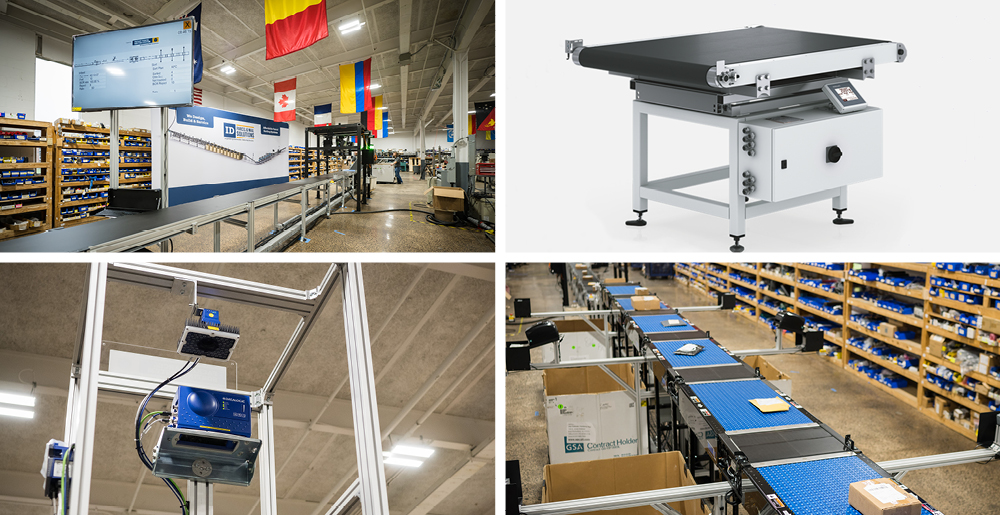
When it comes time to incorporate a new automated parcel sorting system into your ecommerce or parcel processing operation, several factors will come into play when determining the needs of the system. Not all available features will be necessary, however choosing the right ones will help ensure your goals are being met and the system is delivering the maximum value for your investment.
At ID Parcel & Mail Solutions we work with companies from the start to analyze specific customer sorting requirements and then we custom design our Packet Parcel Sorting System (PPSS) with only the necessary components. This way you’re not budgeting for ancillary components that are nice to have, but not critical to achieving the goals of the system. This guide will help you to better understand the features available.
There are several factors to consider when determining the features that will be required of your automated parcel sorting system. These include the size and type of parcels that will be processed, package volume for normal and peak periods, required throughput rate, and data needs. You’ll also need to understand any space limitations that your facility may have and factor in the potential to scale the size and functionalities of the system in the future.
Various technologies and solutions exist that can improve the efficiency of an automated parcel sorting system. This guide covers the features that are typically used for smaller operations, or large operations with lower volume applications. Let’s dive into the typical components, starting from the front of the line.
The induction solution is the position at the very start of the line that typically consists of a belt conveyor. This is where packages enter the Packet Parcel Sorting System (PPSS) for processing. Solutions can range from simple manual induction to more automated methods.
Manual induction requires operators to manually pick and singulate parcels, as featured in the image below of the ID Parcel & Mail Solutions Packet Parcel Sorting System (PPSS). In a manual setup, depending on the throughput requirements, the induction solution belt will be sized to accommodate between 1 to 6 operators for systems processing between approximately 20 – 140 parcels per minute. Operator feeding stations can be set up in alternating positions on opposite sides of the belt. Manual induction solutions are simple to use and have a lower investment cost. Operators ensure that parcels are evenly placed between the lines on the belt and justified to the guide rail. This ensures gapping and optimal placement without significant additional capital cost.

Induction Solution on the ID Parcel & Mail Solutions
Packet Parcel Sorting System
There are multiple features along the automated parcel sorting system that are designed to help increase throughput and reduce labor requirements. The semi-automatic Induction Feeder is a step up from the manual feeder. Here, a large dumper bin is automatically tilted towards the conveyor, allowing parcels to fall onto a belt. This belt then meters multiple packages onto the induction belt at a pace that a smaller number of operators can quickly finalize as the packages move towards the next section of the automated parcel sorting system. Although workers are still required to singulate parcels, the dumper will reduce the quantity of workers required at the induction point.
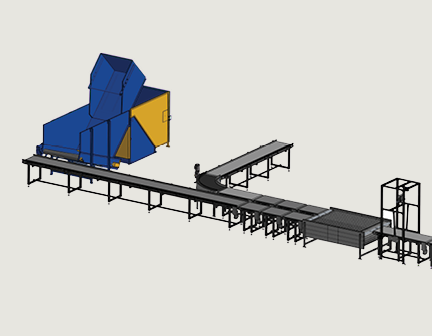
Semi-automatic induction for PPSS
Depending on the design of the semi-automatic induction system, it could also include small gapping conveyors to further separate packages and possibly a merging conveyor to merge packages into a single stream prior to entering the DWS (dimensioning, weighing, and scanning) section of the system. Gapping and merging are achieved by measuring the lengths of packages and varying the conveyor speeds to create necessary space between the packages and then if merging, bringing the packages into a single stream. This intelligent machine control reduces the number of required feeding operators.
Barcode readers scan packages, and the labels on them, to help determine the tracking numbers so as to match pieces to defined data or determine the sorting route directly from the data in the barcode. A sortation route or sorting outlet is then assigned to the parcel. If the package requires labeling, the new label is matched to the package via the PPSS software. The type of barcode reader that you choose will be dependent on a variety of factors. These include the range of package sizes that need to be scanned, the types and sizes of barcodes that are scanned, whether the barcode is in one view of the packages or if multiple views are required to find the barcode and by the system throughput requirements. More advanced technologies will scan more sides of the parcel and scan at higher speeds
Laser scanners work by projecting laser light onto the surface of the label. The reflected pattern is then converted into electrical energy, then data, at which point it is sent to the computer. Laser scanners have a limited field of view, making them slightly less flexible for wide ranges of package sizes and barcode placement within the field of view. This option, however, tends to be less expensive as they do not require as much supporting technology, such as an image processor. One other drawback is that they cannot read 2-D codes.

PPSS with both a Datalogic Matrix 320 5 Mb Image
Scanner and DM3610 Dimensioning system mounted over the conveyor.
Image scanners, also known as area scanners, work by capturing multiple images of the package until an image of the barcode is identified. ID Parcel & Mail Solutions uses this technology frequently on the Packet Parcel Sorting System (PPSS). Here, a microprocessor detects the code within one or more of the images, decodes it and sends it to the PPSS computer for processing. Resolution plays an important part of establishing an accurate capture. Image scanners are available in a range of resolutions and lens types to match the sizes and types of barcodes that will be processed. Lighting is also an important factor when considering image scanners. Proper lighting is required to acquire an effective code from the images. Lighting can be integrated into the image scanner setup, or managed externally.

Datalogic AV900 High Resolution Barcode Scanner with LED lighting.
Tunnel based barcode readers make automated parcel sorting exceptionally fast and efficient. They work by placing multiple image scanners on a frame at the top, sides, and sometimes underneath the conveyor. Up to six views can be captured via imagers and mirrors. Because the system is so fast at capturing the data, parcels can be placed with less space between them and without concern for where the barcode is facing, resulting in faster feeding and higher throughput. In addition to the imaging equipment, vision tunnels also require additional lighting to illuminate the multiple angles and views. These factors make this technology a significant capital investment. As a result, Vision Tunnels are typically used on larger systems delivering10,000 or more parcels per hour.
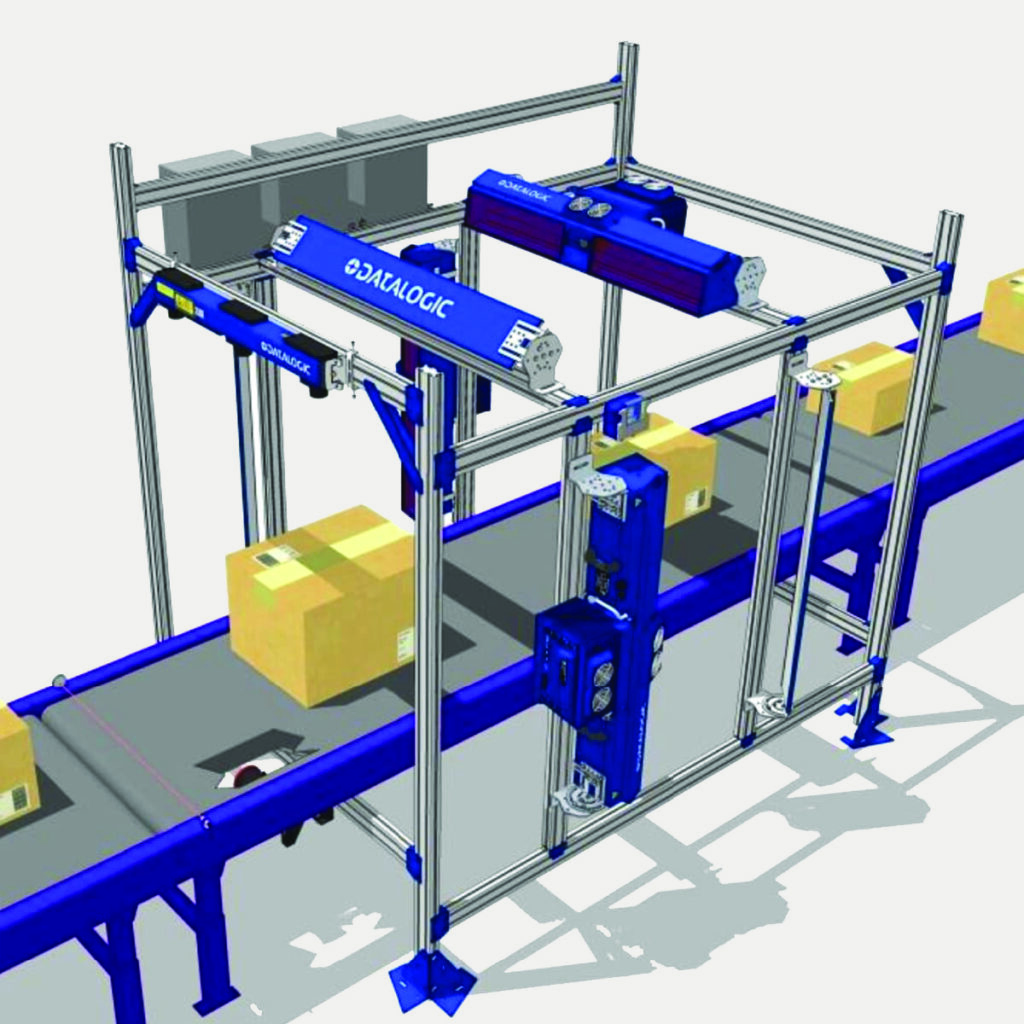
Datalogic multi-sided omni directional scan tunnel
Dimensioning Systems scan and measure parcels to determine their size. They are typically combined with a scale built into the conveyor line that captures package weight. The main goal of dimensioning technology on an automated parcel sorting system is to calculate package size and assign proper shipping costs and services. Since carrier shipping costs are based on weight and size, having accurate measurements is key to keeping shipping costs as low as they can be for each parcel.
Various dimensioning systems exist with a range of speed and capabilities. The right system will be determined by your throughput requirements as well as the type of parcels or packets you will be processing. Important questions include accuracy level and certification requirements such as Legal for Trade as well as the range of sizes and weights for processing.
This style of dimensioner uses an infrared light signal that is initiated when the parcel triggers a sensor. The light is reflected back to the sensor and the time that it takes to bounce back determines how the parcel is 3D mapped. Although ToF cameras are a less expensive option, they require parcels to be mapped at a slower rate than other technologies. Multiple cameras will more accurately and quickly scan; however, they need to be placed with significant space between them because the light signals they emit cannot overlap with other units.
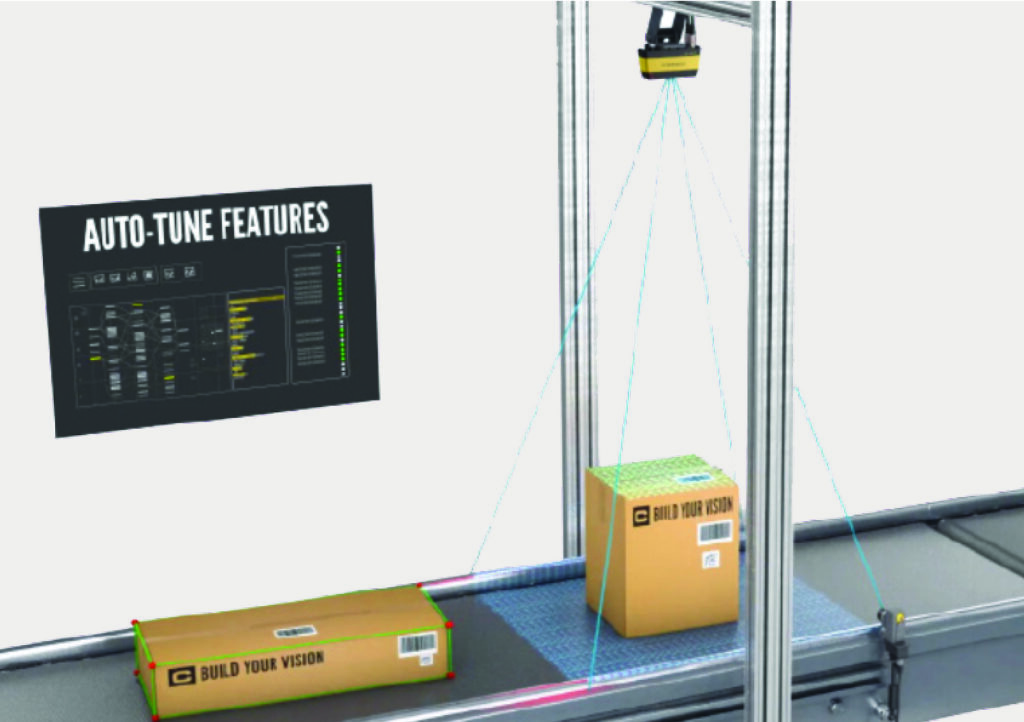
ToF Dimensioning system over automated parcel sorting system
Laser Dimensioners work by passing the parcel through a series of laser lines. Several varieties of laser dimensioners are available. For example, measuring light screens use an array of closely spaced light beams to map the parcel. This technology is reasonably priced and provides effective data, which is critical to properly rating each parcel.
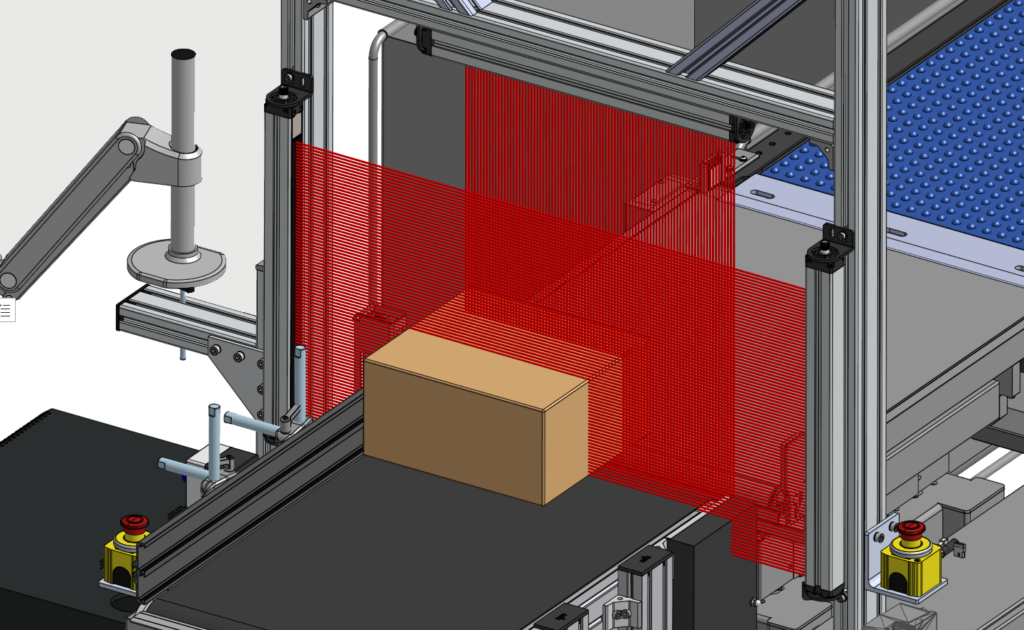
Banner EZ-Arrays for capturing package dimensions on PPSS

Datalogic DM3610 Single Head Dimensioning
System below AV900 BCR
The Opto-Electrical Measurement Instrument, by Datalogic, can be used as a standalone device solely for computing parcel dimensions. When two heads are used, however, a controller, that computes parcel dimensions, and the heads continuously scan its field of view and measure and transmit distance or “range” data to the controller. Using two heads yields more accurate dimensioning of irregular packages.

Datalogic Two-Headed Dimensioning System
As discussed, conveyor belt scales are used to capture the weight of each parcel in order to establish eligibility for the lowest shipping rates. These conveyor scales are typically placed between two conveyors. Parcels are weighed as they pass over the scale conveyor. Once the weight is captured it is passed to the PPSS system software. Like the other features in this guide, various scale technologies are available to automated parcel sorting systems. The two main types that ID Parcel & Mail Solutions uses on our Packet Parcel Sorting System (PPSS) are as follows.
This type of scale is a more affordable solution and intended for weighing parcels at throughputs lower than 4,000 pph. They can be put in Legal for Trade mode if required and can handle a range of weights from as low as 0.1 lbs up to 20 lbs or more on the lower end.
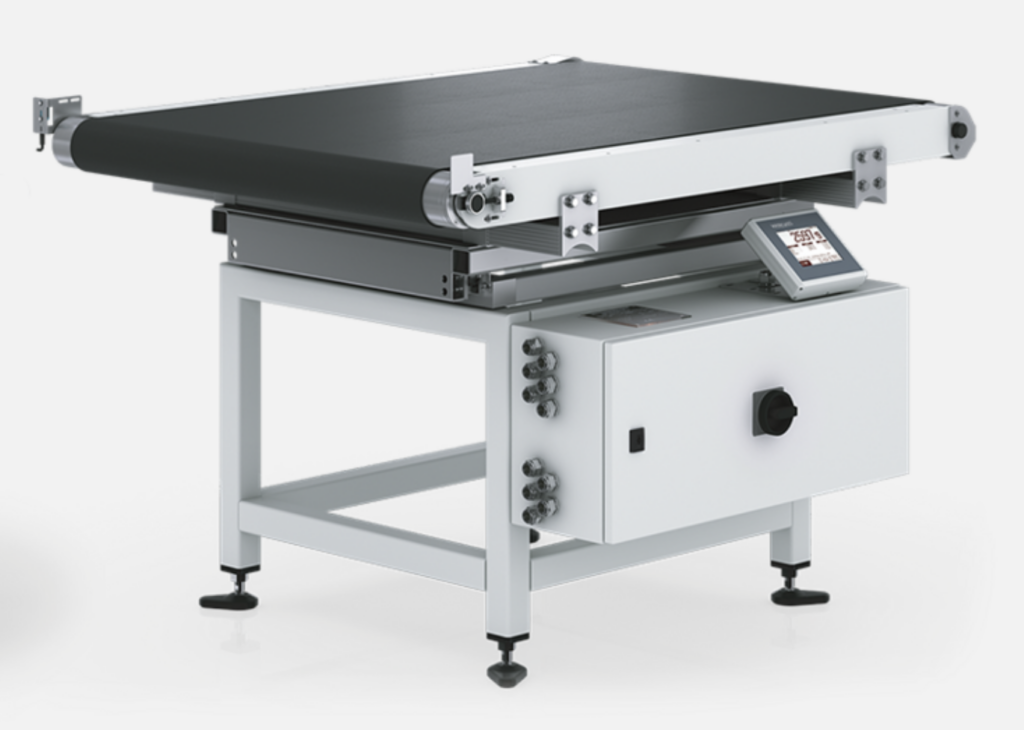
Wipotec HC-FL series scale
Multi Conveyor scales use either two, three or four scales. As the number of scales increases, the accuracy, speed and range of weight data is increased. Both large and small parcels have more time to spend on the weigh bridge, allowing more data to be processed. This technology allows the line to move at higher belt and throughput speeds while maintaining high accuracy. It is therefore appropriate for higher throughput requirements.

Wipotec HC-FL-2 double scale
Automatic print and apply labelling applicator systems eliminate the need for manual labeling, speeding up the parcel process when labeling is required, and helping to avoid errors. After the parcel passes through the barcode reader, the label data, and its placement on the package, is collected and passed to the labeling applicator. The automatic labeler then applies the label in a precise manner to ensure the existing label is covered or not covered, depending on the customer’s requirements. At ID Parcel and Mail Solutions we typically use the Panther Predator on our Packet Parcel Sorting System (PPSS).

Two Panther Preditors mounted over PPSS conveyor
for automatic print and apply labeling
This technology eliminates the need for workers to manually scan, print and apply labels, reducing the overall number of workers required to operate the system. They also provide increased accuracy of label placement and ensure the proper labels are being applied. In addition, automatic labelers can work with a variety of different parcel types and sizes and application locations. Different styles of labelers are available that apply labels to the top or sides of the parcel. The range of automatic labeling systems vary by speed, label quantity, and size of label, among other features.
Manual labeling on the PPSS is a lower capital cost and work through creative design of the PPSS conveyors for moving packages through the system. Manual labeling stations work by first having operators pick the parcel from the accumulation conveyor as it is passing through the system and then scanning the barcode at the station. The label is then instantly printed by the label printer, applied by the operator to the parcel, and placed back onto the conveyor line on a Takeaway conveyor.

Manual Labeling Station alongside the Accumulation and
Takeaway Conveyors on a PPSS.
When analyzing the feature requirements of your next automated parcel sorting system, it’s important to understand that sometimes automated features are not necessarily more cost effective. Automatic labeling applicators have their place on higher throughput models or simpler labeling applications, but manual barcode labeling stations cost less and may be more cost effective when used for complex labeling applications or on smaller systems. They also may be necessary if the labeling requirements are diverse or change frequently.
Any automation system is both dependent on package data and an excellent tool for gathering data that customers may not have traditionally captured due to the high costs of doing so manually. Given the amount of data that a system can require and collect, selecting the right data tools for integration, storage and analysis of the data is critical for a successful Automated Parcel Sorting System investment. Some of the technologies and methods are:
A SQL database is used to store all machine data on an automated parcel sorting system and provides a dynamic database architecture. ID Parcel and Mail Solutions works with clients to define an interface between the client and the Packet Parcel Sorting System (PPSS). This interface allows the information captured by the system to be sent to the client. The client then provides a response with the relevant information (ZPL data for label printing, sort codes or locations, expected weight or dimensions versus actual weight and dimensions, etc.).
ID Parcel & Mail Solutions also builds interfaces to a customer’s IT system via customer provided RestAPIs or other software integration methods. By allowing customers to maintain the business logic of their process, customers can quickly and cost effectively adapt those rules without incurring delays and additional fees from the automated parcel sorting system manufacturer. The system provides the means of capturing data more productively and executing client business processes at much lower cost per piece.
After parcels are scanned, measured, weighed and labeled, sorters automatically divert them to their intended destination based on the information obtained. A range of sorter types are available. The type that is right for your operation will depend on several factors including necessary throughput and parcel type, shape and size. For a full breakdown of sorter types, their specific applications, and pros and cons for each, please downloadThe Pros and Cons Of Different Parcel Sorting Technologies.

PPSS with MODSort ARB Conveyors and Sorter Control Panels
and Label Printers for Piece to Container Tracking
At the end of the line, the sorters move packages to their allocated container. Upon closing containers, container labels with barcodes are printed by the PPSS that provide a licence plate for the container and its content. The Sorter Outlet Control Panel provides a visual and easy to use touch screen for operators to quickly manage opening and closing containers and printing the container labels. This provides piece to container tracking when processors require a custody trail for packages.
Operators and managers of automated parcel sorting systems rely on system displays to monitor the status of the system or line. Large screens allow for improved visual communications on the performance and status of the system and the parcels as they move through the various stages of automation. This is a simple addition to the system that can have a significant impact on the ability to manage the automation operation and effort to avoid errors.

Large Screen Display for System Status on PPSS
For those that require an additional level of trackability, radio-frequency identification (RFID) tags can be placed on each package. When RFID tags are included on parcels they are scanned when passing through the RFID tunnel. The data is then passed to the PPSS System and customer database associated with the package tracking barcode, proving the ability to track in greater detail. This is typically used on higher value content packages and helps identify the location of parcels, for shipping updates, and can reduce the chances of losing parcels.
Now that you have a handle on the features available to automated parcel sorting systems, you’ll be better positioned to evaluate your specific system requirements. Reach out to ID Parcel & Mail Solutions for further guidance. We will work closely with your team to ensure that the features you ultimately choose will help you achieve your goals.